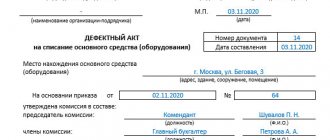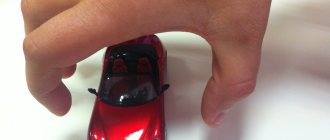By purchasing a car, the owner assumes additional responsibility and risks associated with possible illegal actions in relation to the property. This also applies to damage to a vehicle, which can be caused equally either intentionally or accidentally.
Often, having damaged someone else's car, the culprit prefers to silently hide, leaving the owner of the car to repair the damage on his own. In our article we will look at what liability is provided for damage to someone else’s property, in particular, everything related to a car.
Important! If you are dealing with your own case related to car damage, then you should remember that:
|
Article of the Criminal Code of the Russian Federation
If damage was caused to the car, compensation and punishment will be carried out in accordance with the current provisions of the Civil and Criminal Code of the Russian Federation. Depending on the nuances of the situation, I can use:
Attention! If you have any questions, you can chat for free with a lawyer at the bottom of the screen or call Moscow; Saint Petersburg; Free call for all of Russia.
- Article 167 of the Criminal Code of the Russian Federation; (Intentional destruction or damage to a car)
- Article 168 of the Criminal Code of the Russian Federation; (Destruction or damage to a car due to negligence)
- Article 1064 of the Civil Code of the Russian Federation (General grounds for liability for causing harm)
The exact choice of legal act depends on whether the damage was caused intentionally, or whether the car was damaged as a result of unintentional actions of a person.
Damage and destruction of property
Damage is considered as the loss of a part of a thing’s useful properties, and after some repair or restoration, the thing can again be suitable for use and perform its inherent functions.
Lawyer's opinion
Dmitry Ivanov
Legal Support Center
This article talks about typical ways to resolve the issue, but each case is unique. If you want to find out how to solve your particular problem, call:
Or on the website. It's fast and free!
The destruction of property means its complete loss as a result of causing significant damage to it that cannot be restored, i.e. the property ceases to exist and, accordingly, to fulfill its purpose.
Damage (destruction) of objects can be intentional, when the culprit knowingly causes damage to things, or unintentional, which is accidental damage or destruction of objects as a result of careless handling or imprudent actions.
The qualification of the degree of harm and the choice of punishment for the guilty person is established based on the legislation of the Russian Federation. Administrative offenses are described in Art. 7.17 Code of Administrative Offenses dated December 30, 2001 No. 195-FZ (Administrative Code). Criminal liability is provided for in Art. 167, art. 168, art. 214 of the Criminal Code of the Russian Federation.
Damage to property is also a controversial concept and requires more detailed clarification. This concept, again, is evaluative, therefore, specifying the direct damage is just as important as carefully applying sanctions in relation to a person who may be suspected of committing a given crime.
The question arises as to whether the actions committed by a specific person fit this article. An intentional act similar in description to Art. 167 of the Criminal Code of the Russian Federation, but different in meaning, can serve as a categorically incorrect sentencing of the defendant.
The destruction of property means the complete loss by its owner of the useful properties of a certain item. Based on this interpretation, damage is understood as a partial loss of the very benefits that their owner could have received if the thing had not been damaged. As for quantitative measurements, a decrease in quantity of certain goods is also a possible consequence of this crime.
Punishment
The severity of the punishment directly depends on the article under which the damage caused to the car falls. The Civil Code of the Russian Federation stipulates that a person who causes damage to the property of another citizen is obliged to compensate the cost of the loss in full. However, additional punishment is provided. In accordance with the provisions of the Criminal Code of the Russian Federation, the culprit of the incident may:
- involve in compulsory work;
- imprisonment for up to 5 years;
- assign corrective labor;
- force to pay a fine, the amount of which can reach up to 120,000 rubles.
The choice of punishment depends on the circumstances of the incident. The most severe measures are applied only in particularly serious cases. Typically, the term of imprisonment for causing damage to a car does not exceed 2 years, and the fine is 40,000 rubles. or 3 months salary. The exact list of measures that will be applied to an unscrupulous citizen is determined individually and depends on the nuances of the current situation.
What is unintentional damage to property?
There are not only criminal sanctions for damaging and destroying someone else's property. If the offense is minor, the case will be limited to an administrative charge.
Article 7.17 of the Code of Administrative Offenses of the Russian Federation provides for punishment for violations that result in minor property damage. For example:
- broken glass items (window in the entrance, crystal vase, etc.);
- cable break;
- scratching the surface of an object (for example, the front door);
- damage to small household appliances or gadgets;
- damage to bags, shoes, clothes, footwear.
For such an offense, the attacker faces a fine of 300 to 500 rubles.
Unintentional damage to property is rendering it unsuitable for further use by certain actions of a specific person, committed carelessly or unaware of the seriousness of the consequences. This also includes situations that the offender foresaw, but hoped to prevent.
There are cases when a person, in certain circumstances, committed an action that resulted in damage to someone else’s property, unintentionally. At the same time, he is accused of intentionally causing material damage, for which he faces punishment under Article 167 of the Criminal Code. There is no evidence of unintentional action. In such a situation, the easiest way is to resolve the issue directly with the owner of the damaged property.
If the victim refuses to accept the offer of voluntary compensation for material damage and wants to resolve the issue in court, the culprit remains to hire a lawyer, especially when it comes to a large sum of money or a serious punishment. A legal specialist with experience in such cases will tell you what to do correctly in a particular situation.
Unintentional damage to someone else's property means causing harm to someone else's property that has material value and expression, without direct intent for such an outcome.
Punishments against the offender are applied when the unlawful act committed meets two conditions:
- The amount of damage caused as a result of careless actions by the guilty person exceeds the mark established in the Criminal Code for large damage of 250,000 rubles;
- Damage to property was caused by careless handling of fire or other sources of increased danger.
Criminal actions that caused unintentional damage to property entail holding the guilty person accountable under the Criminal Code. However, the application of punishment against the offender is possible only in cases where the damage caused by his actions is considered major.
The offender faces one of the following penalties:
- Fine of up to 120,000 rubles;
- Performing mandatory work for up to 480 hours;
- Carrying out correctional work, the maximum duration of which should not exceed 2 years;
- Restriction of freedom. The maximum sentence is 1 year;
- Carrying out forced labor for up to 1 year;
- Imprisonment for up to 1 year.
Bringing the guilty person to justice is possible only in cases where major damage has occurred as a result of unintentional damage or complete destruction of property.
Accordingly, if the value of the lost property is below this level, bringing the guilty person to criminal liability is not allowed.
In practice, there are quite often cases when a person destroys or damages someone else’s property through negligence. Bringing a criminal to punishment is possible only if the following circumstances exist:
- The amount of damage caused as a result of the misconduct exceeds the mark of 250,000 rubles;
- The damage was caused due to the offender’s improper handling of a source of increased danger.
Criminal or administrative punishment is provided for a crime committed intentionally (on purpose). If the criminal had the direct intent to damage property worth more than 5 thousand rubles, the victim can file a claim based on the fact of the crime.
Evidence of the defendant's intent usually comes from crime scene videos or the testimony of unrelated witnesses. But the court may also consider other indirect evidence.
Vandalism
In the event that public property was destroyed or damaged (smashed, broken, covered with obscene words and graffiti, etc.), then we are talking about
act of vandalism
. Public property includes buildings and structures, public transport, stops, property located in parks and recreation areas (benches, lanterns, trash cans). Responsibility for vandalism is provided
Article 214 of the Criminal Code of the Russian Federation
.
- an administrative fine of up to 40 thousand rubles or wages for a period of up to 3 months;
- correctional work;
- compulsory work;
- imprisonment for up to 2 years (in case of a particularly large amount of damage).
We suggest you read: The order of grandchildren when inheriting property
But punishment will follow only if the value of the damaged property was more than 5 thousand rubles and such damage was significant for the victim. The court determines the significance of the damage privately based on the level of income of the victim in comparison with the damage, the presence of dependents in the care of the victim and the presence of other aggravating circumstances.
The degree of liability of the defendant is also aggravated if, as a result of the destruction of the thing, physical harm was caused to the defendant or a third party (several persons).
Watch the following video about the intentional destruction or damage of someone else's property
Damage to property that was carried out without direct intent (accidentally) and the intentionality of which could not be proven is considered unintentional. A person who accidentally damages someone else’s property may be held criminally liable when the amount of damage to the plaintiff is more than 250 thousand rubles, and the property is damaged due to arson or explosion.
In this case, the defendant will be awarded one of the following penalties:
- A fine of up to 120 thousand rubles.
- Imprisonment for up to 1 year.
In the article https://lexconsult.online/6689-posledstviya-umyshlennogo-neumyshlennogo-podzhoga-po-uk-rf find out how much they give for intentional arson.
Causing damage to a car through negligence
A person does not always cause damage to a car on purpose. In a number of situations, property may be damaged due to negligence. In this case, Article 168 of the Criminal Code of the Russian Federation comes into force. In order for a legal act to be applied in practice, the following conditions must be met:
- The amount of damage caused by negligence is at least 5,000 rubles.
- Property is damaged or destroyed as a result of the use of sources of increased danger.
If the loss of the car was caused by negligence, the person responsible for the incident must compensate the cost of the damage caused to the vehicle in full. The law allows you to take the following actions to compensate for the damage caused:
- pay for repair work;
- compensate for losses incurred by providing funds;
- replace the item with a similar one.
The specifics of compensation and the amount of compensation will be established during the trial.
Damage to property due to negligence - Article 168 of the Criminal Code of the Russian Federation
Life is complex and unpredictable: often a person becomes a source of other people's problems, without wanting it.
The developers of criminal regulations tried to provide for this by establishing the following types of liability for an accidental culprit :
- monetary punishment up to 120 thousand rubles;
- payment towards the affected annual income;
- work: compulsory, corrective and forced (for a period of up to 480 hours, up to two years and a year, respectively);
- prison (the term here depends on the degree of unseemly behavior - maximum 12 months).
It is worth noting: the main semantic points of this legal text: the large size of the damaged/destroyed objects and the unintentional actions of the criminal (frivolity/negligence). And “large” in criminal law is calculated from the amount of a quarter of a million rubles.
The comments to the text say that the action applies to people over 16 years of age. So some “children under 18” are mistaken, hoping that they will not face serious punishment for a bad act.
Causing damage to a vehicle by third parties
The situation is classic. If the car was damaged by third parties, Article 167 of the Criminal Code of the Russian Federation comes into force. It assumes that the citizen committed the act of his own free will. Intent in this situation is expressed in the desire to destroy or damage a car belonging to another person. If the citizen did not intend to cause damage to property, another article of the Criminal Code comes into force or civil legislation is applied altogether.
For the court to begin proceedings under Article 167 of the Criminal Code of the Russian Federation, the damage caused to the vehicle must be insignificant. The parameter is determined in each situation individually. The action is carried out by the court. Proceedings will be initiated only if the amount of loss exceeds RUB 5,000.
In the current situation, as a punishment, a citizen may be subject to compulsory or correctional labor, and will also be required to pay a fine of up to 40,000 rubles. If the situation is particularly serious, the person may be imprisoned for up to two years.
If the damage to the car was caused for the sake of hooliganism, the punishment becomes more severe. If the culprit of the incident blew up or set fire to a car, and as a result of a negligent act, a person died, the length of the prison term increases to 5 years.
Compensation for harm in this situation is carried out according to the standard scheme. The citizen must compensate the owner of the vehicle for the damage caused in full. If the damage to the car was caused by a person in a difficult financial situation, the severity of the punishment may be reduced. However, the rule is not applied in practice if a person was injured as a result of actions that caused damage to the car.
Application of administrative liability for damage to a car
The case is being considered under Article 168 of the Criminal Code of the Russian Federation. It states here that criminal liability occurs only in the following cases:
- severe consequences;
- causing damage on an especially large scale. The minimum threshold is set at 250,000 rubles;
- careless handling of fire or other sources of high danger.
If we consider the last point, fire is considered a force of nature; it must be handled very carefully and in compliance with safety rules. Otherwise, there is a high risk of severe consequences. Thus, careless handling of fire, resulting in damage to someone else’s property, is punishable under the Criminal Code.
The perpetrator cannot plead that he did not know or did not appreciate the seriousness of the consequences of his own actions. As an example of such situations, we can consider smoking at gas stations, lighting fires in prohibited places. Also, if heating electrical appliances were left unattended, the case is considered according to the same scheme.
Sources of increased danger are understood as:
- mechanisms, the handling of which requires strict adherence to safety rules;
- machines that need to be operated according to an established scheme;
- electrical appliances that pose a danger if operating rules are violated.
As for the severe consequences, this means damage to property, which led to the shutdown of large enterprises, leaving the victims without housing and means of subsistence. Also severe consequences include the cessation of water supply, electricity supply, gas supply due to certain actions of a citizen or group of persons.
In other situations, criminal liability is not provided. The injured party may recover compensation for damages from the culprit in court by filing an appropriate claim with the authorized body. Of course, in order for a claim to be satisfied, there must be direct evidence of the defendant’s involvement in a specific case. This may be witness testimony, video footage from surveillance cameras, or other facts confirming the victim’s words.
When a person does not know who damaged his property, it is necessary to file a statement with the police. Here it is important to describe the case and all its circumstances in as much detail as possible. The police will then conduct an appropriate investigation and notify the applicant in writing of its findings.
Any interpretation of the law requires quite a lot of experience and confidence in the interpreted lines. In general, property damage, like many other concepts in jurisprudence, is evaluative. Each person, not necessarily a lawyer, will assess the degree of damage to property in his own way, applying the relevant rule of law in a completely different way.
The strength of the letter of the law is determined by its fairness and accuracy, therefore, individual paragraphs of the article require more detailed analysis and clarification.
The specific part implies responsibility for actions that led to generally dangerous consequences. This requires greater justification for the concept of general danger.
What is meant by generally dangerous consequences? This could be a collapse, flooding, or the use of destructive natural forces. The most important difference is that such a threat ultimately targets a large number of people.
As for the possibility of causing death to a person, damage to someone else’s property, as a concept, allows us to indicate that this paragraph implies only an act committed through negligence. Otherwise, if there is intent, such types of crimes are classified exclusively as intentional murder.
Other serious consequences that can be caused to people include harm to people’s health, production or enterprise operations being stopped, failure to fulfill contractual obligations, destruction of particularly valuable property, as well as the occurrence of some kind of disaster, in connection with which people may be left without housing, food and livelihood.
If the damage caused to the owner of the car is minor, for example, we are talking about deliberate damage to the wheel of someone else’s car, the repair of which costs less than 2,500 rubles, then law enforcement officers draw up a protocol, and liability is assigned under Art. 7.17 of the Code of Administrative Offences. Under this article, a person who has violated the law may be given a fine of 300-500 rubles.
Payment of a fine imposed on the basis of the Code of Administrative Offenses does not relieve the violator of civil liability, which is defined in Article 1064 of the Civil Code of the Russian Federation. It says that the person responsible for the damage is obliged to compensate for the damage caused in full. The same applies to those persons to whom liability was applied under the Criminal Code for causing significant harm.
If, when assessing damage caused intentionally to someone else's property (which in the case we are considering is a car), an amount exceeding 2,500 thousand rubles is established, this offense is subject to consideration and determination of liability under the Criminal Code of the Russian Federation. The basis is Article 167, according to which it is possible to appoint:
- a fine (its amount can reach 40 thousand rubles or be equal to the amount of three months’ earnings of the perpetrator);
- compulsory work (for up to 360 hours);
- correctional labor (up to one year);
- arrest, which can last up to three months;
- forced labor or imprisonment.
If damage to a car in the yard is considered under this article, committed for hooligan reasons, arson or another method dangerous to the public, or the event resulted in serious consequences (for example, injuries or unintentional death), then the perpetrator faces imprisonment for up to five years.
The Criminal Code of the Russian Federation also provides for a separate article for damaging a car as someone else’s property if the actions that led to the damage were not intentional, i.e., committed through negligence. Thus, an act can be qualified only if the following conditions are met:
- the damage caused is large (its amount amounted to more than 250 thousand rubles);
- damage occurred due to the use of fire or another source of increased danger.
For such acts a fine of up to 120 thousand rubles is possible. or in the amount of the total annual income of the perpetrator, it is also possible to assign compulsory labor, correctional or forced labor. In rare cases, imprisonment is awarded, but the term cannot exceed one year, and such punishment depends on many nuances.
We invite you to read: Division of property of cohabitants in a civil marriage
Only persons who have reached the age of 16 at the time of committing criminal acts can be subject to criminal punishment for intentional damage to someone else’s car. In cases where the incident led to aggravating circumstances (for example, people died), liability can be applied from the age of 14.
If we are talking about minor damage to someone else’s property, in particular, a car, and a fine is awarded under the Administrative Code, then the imposition of such a sanction is provided for a person over 16 years of age. As for material compensation for damage under the Civil Code, if the child is under fourteen years of age, then this responsibility rests with the parents.
As you can see, such, at first glance, not the most terrible problem, such as damage to someone else’s car, can lead to serious problems for the person at fault. And if you have become a victim of such a crime, then in order to ensure that all your interests are protected, the damage is fully compensated, and adequate measures are taken in the case, be sure to contact an experienced lawyer.
Damage to a vehicle during construction work
If the damage to the car was caused as a result of repair work, the procedure for holding liable and receiving compensation becomes more complicated. The fact is that the culprit of what happened is not always known.
In such a situation, experts advise that you must call a traffic police representative to the scene of the incident. An employee of the institution must draw up an appropriate conclusion. It records information about the circumstances of the incident. Based on them, a citizen can try to find out who is responsible for the incident.
If it is possible to obtain the necessary information, the citizen can contact the person or organization with a demand for compensation. To complete the action, a claim is filed. The amount of payment is determined based on expert opinion. The victim can claim full compensation for damage caused to the car.
If the person responsible for what happened to the car refuses to pay for repairs or provide funds to the victim, the citizen must file a lawsuit. All available supporting documentation must be attached to the application.
Damage to property from the point of view of the law
If we talk about damage, it means causing damage to the car to such an extent that the car loses value and is not used for its intended purpose for some time (during repair work). If we are talking about an irreversible process that has led to the fact that the car cannot be restored and cannot be used in the future, then this is considered as destruction.
- administrative;
- criminal;
- civil.
Causing damage to a car with a barrier
If the car was damaged by a barrier, the driver can file a claim with the owner of the parking lot or other place where such equipment is installed.
As in the case of damage to a car during repair work, the fact of the incident must be documented. To do this, you must call the traffic police. Without recording what happened on paper, you will not be able to receive compensation.
Payment will be provided only if the fault of the parking lot owner is proven. If the driver is at fault for an accident with a barrier, he will not be able to receive compensation. The decision on whether to provide payment will be made by the court.
At the car wash
If your car was damaged at a car wash, the damage must be recorded immediately. To do this, you can perform the following manipulations:
- film a video;
- take pictures of the damage to the car;
- draw up a corresponding act.
Then you need to write a complaint to the management of the car wash. The document must be drawn up in writing. It should indicate the amount of damage to the vehicle and the request for compensation. The list of further actions depends on the behavior of the car wash manager. The owner of the company may agree to compensate for the damage received or refuse to carry out such manipulation.
1 situation is much simpler. If the company agrees to cover the cost of car repairs, the promise must be put in writing. The action is necessary in order to subsequently have documentary evidence of the admission of guilt by the management of the organization.
If the company refuses to pay and claims that the incident is not its fault, the injured car owner must complete all documents in accordance with the rules. It will be necessary to involve representatives of the competent authorities. Next, an independent examination of the damage caused is carried out. Its purpose is to establish the nature of the damage received and identify the cost. When the expert opinion has been received, you must contact the car wash again with a claim. The injured car owner may also include the cost of the examination in the amount of compensation.
If the owner of the car wash still refuses to compensate for the damage, the owner of the vehicle must file a claim in court. It will be possible to receive compensation only if guilt is proven. To do this, the statement of claim must be accompanied by a document drawn up immediately after the damage was received at the scene of the incident and confirming what happened. In another situation, it will not be possible to prove that the damage appeared after visiting a car wash.
1. Do not leave the scene of the incident, do not move the vehicle (hereinafter referred to as the vehicle) and do not touch objects related to the event. In case of damage to the vehicle as a result of a road traffic accident (hereinafter referred to as an accident), turn on the hazard warning lights and place a warning triangle (at least 15 (fifteen) meters from the vehicle in a populated area and at least 30 (thirty) meters from Vehicle outside the populated area). Using photos and videos, record the vehicles and their damage, traces and objects related to the incident in relation to each other and road infrastructure objects. Write down the details of witnesses and eyewitnesses of the event, their contact numbers, details of MTPL agreements (policies).
2. Immediately report to the competent authorities authorized by law to investigate the event, depending on the nature of the incident, and act in accordance with the instructions received from the competent authorities (telephone 112).
- in the event of an accident (including a collision with a parked vehicle of another (including unknown) vehicle, or the fall of foreign objects on the vehicle while it is moving) – to police officers (traffic police);
- in case of damage or theft of vehicle parts by third parties (including damage to a parked vehicle by unknown persons) - to police officers (territorial department of the Ministry of Internal Affairs);
- in the event of foreign objects falling onto a parked vehicle - to police officers (territorial department of the Ministry of Internal Affairs);
- in case of fire (including arson of a parked vehicle by unknown persons) - to the fire service and a police officer (territorial department of the Ministry of Internal Affairs);
- in case of harm to the life and health of the insured persons (as a result of an accident) - to the medical assistance service and police officers (traffic police);
- in case of damage to a vehicle as a result of a natural disaster (hail, earthquake, hurricane, rain, heavy snowfall, flood, subsidence, etc.) - to police officers (territorial department of the Ministry of Internal Affairs) and the Ministry of Emergency Situations (Federal Service for Hydrometeorology and Environmental Monitoring of Russia ).
IMPORTANT!
In accordance with the Insurance Rules, it is not required to receive and provide documents from the competent authorities regarding the fact of the event in the following cases:
- in case of damage to only one headlight, or one lantern, or one mirror element, or one separate element of the interior glazing (if there is no damage to other parts of the body and interior of the Vehicle as a result of the event), without limiting the number of such claims for the entire period of validity of the Insurance Agreement;
- with minor damage to parts and elements of the vehicle body. Moreover, the amount of insurance compensation for such a declared event without providing documents from the competent authorities, regardless of the actual amount of damage caused, cannot exceed 3% (three percent) of the corresponding insured amount specified in the Insurance Agreement at the time of its conclusion. Payment of insurance compensation for minor damage to parts of the vehicle body without providing certificates from the competent authorities confirming the occurrence of an insured event is made only once for the entire period of validity of the Insurance Agreement, unless otherwise specified in the Insurance Agreement, in the “VIP” insurance agreement support programs or in the additional agreement to the Insurance Contract;
- in case of registration of documents about an accident without the participation of authorized police officers within the framework of the simplified registration of road accidents “European OSAGO Protocol”, in accordance with the requirements of Article 11.1. Federal Law of April 25, 2002 No. 40-FZ “On compulsory civil liability insurance of vehicle owners” (hereinafter referred to as the MTPL Law). At the same time, the amount of insurance compensation for such a declared event without providing documents from the competent authorities, regardless of the actual amount of damage caused, cannot exceed the insurance payment limit established by the Law on Compulsory Motor Liability Insurance on the date of conclusion of the Insurance Agreement in the relevant constituent entity of the Russian Federation.
3. If the vehicle was damaged as a result of an accident, if there are other participants in the accident at the scene, fill out the Notification of an Accident form together with the drivers involved in the accident. We draw your attention to the fact that the driver involved in an accident is obliged to inform other participants in the accident information about the MTPL contract (policy), including the number of the compulsory insurance policy, as well as the name, address and telephone number of the insurer, as well as fill out the Notification of an accident form, regardless of the execution of documents about the accident by the police officers who arrived at the scene.
4. Immediately (on the day of the insured event) report the incident to PROMINSTRAKH LLC (hereinafter referred to as the Insurer)
by phone +7 (495) 984-4120 or by calling the dispatch service-6 and follow the recommendations received from the Insurer's employees.
5. Submit a written application about the insurance event to the Insurer at the address of the location of the Insurer's Head Claims Settlement Center, or to the address of the location of the Insurer's Loss Settlement Center in the corresponding region of the Russian Federation. The Insurance Event Application form is available on the Insurer’s website.
An application for an insurance event is submitted in writing by the Insured
or
the Vehicle Owner
(their representatives authorized to perform the specified actions by power of attorney), or a person expressly indicated in the Insurance Agreement as
a Person authorized to drive the Vehicle
:
- subject to contacting the competent authorities regarding the fact of the event - no later than 5 (five) working days from the date of receipt of documents from the competent authorities confirming the fact of the occurrence of the insured event;
- in the absence of an appeal to the competent authorities regarding the fact of the event - no later than 5 (five) working days from the moment the specified persons became aware of the occurrence of the insured event.
6. When submitting a written application, provide the Insurer with originals or duly certified copies of the following documents:
- identification document of the applicant;
- power of attorney for the right to represent the interests of the Vehicle Owner in the insurance company (for legal entities and organizations, as well as in all cases when the person submitting the application is not the Policyholder/Vehicle Owner and/or is not directly indicated in the Insurance Agreement as a Person authorized to drive the Vehicle);
- registration documents confirming ownership of the insured vehicle on the date of the accident (vehicle registration certificate, vehicle passport, self-propelled vehicle passport (for special equipment), etc.);
- a document confirming the right to receive insurance compensation in case of damage to a vehicle belonging to another person (in the event that insurance compensation is received by a person who is not the Vehicle Owner).
- a driver's license of the person who was driving the insured vehicle at the time of the accident, or another document of the established form provided for by the current legislation of the Russian Federation for the right to drive a vehicle of the corresponding category;
- waybill or power of attorney for the right to drive an insured vehicle on the date of the event (for legal entities and organizations);
- notification of an accident (if the vehicle was damaged as a result of its collision with the vehicles of other participants in the accident);
- the insurance contract and all additional agreements concluded thereto;
- a document confirming the fact of payment of the insurance premium/contribution (a receipt for the insurance premium or a payment order);
- additional documents provided for by the Insurance Rules and requested, if necessary, by the Insurer to make a decision on recognizing the declared event as an insured event.
7. If, following an event, an appeal was made to the competent authorities authorized by law to investigate the event, provide the Insurer with additional originals or duly certified copies of the following documents issued by the competent authorities:
a) in case of contacting police officers (traffic police):
- a protocol on an administrative offense or a ruling on the initiation of a case on an administrative offense (if the specified document was drawn up by authorized police officers);
- a resolution in a case of an administrative offense/termination of proceedings in a case of an administrative offense or a ruling on the refusal to initiate a case of an administrative offense (if the specified document was drawn up by authorized police officers);
- a certificate of a traffic accident in the form of the Appendix to the order of the Ministry of Internal Affairs of Russia dated 04/01/2011 No. 154 (for road accidents that occurred before 10/20/2017);
- act (conclusion) of a medical examination of a participant in an accident (if such an examination was carried out);
b) in case of contacting police officers (territorial department of the Ministry of Internal Affairs):
- notification coupon;
- certificate from the territorial department of the Ministry of Internal Affairs (form No. 3) (at the request of the Insurer)
- a resolution to initiate a criminal case, or a resolution to refuse to initiate a criminal case based on the fact of the event;
c) in case of contacting the fire protection service:
- fire report;
- a certificate of fire or a fire-technical examination report on the causes of the fire (if such an examination was carried out).
d) in case of contacting the Ministry of Emergency Situations (Federal Service for Hydrometeorology and Environmental Monitoring):
- a document (certificate) confirming information about the nature and duration of the relevant natural disaster or other dangerous natural phenomenon, if the insured property is damaged as a result of such phenomena.
e) in the event that a decision is made on the event by the judicial authorities of the Russian Federation:
- a decision of a judicial authority that has entered into legal force.
By agreement with the Insurer, it is possible to provide other documents from the competent authorities, which must contain information about the date, time and place of the event, information about the damaged vehicle and a description of the damage received, information about the nature and cause of the event and confirmation of the fact of its occurrence.
Advertisement
- the original or a copy of the accident notice certified by the insurance company of the victim under compulsory motor liability insurance/the cause of harm under compulsory motor liability insurance, signed by both drivers, participants in the accident, and duly executed (at the request of the Insurer). Instructions for jointly filling out the Notification of an Accident form by drivers involved in an accident without the participation of authorized police officers are provided on the Insurer’s website.
- a copy of the inspection report of the damaged vehicle of the tortfeasor, participant in the accident, certified by the insurance company of the victim under compulsory motor liability insurance/the causer of harm (at the request of the Insurer);
- data on the circumstances of damage to the vehicle as a result of an accident, recorded by its participants and transferred to the automated information system of compulsory insurance (in case of such recording):
- with the help of technical control means that ensure the prompt receipt of information generated in an uncorrected form based on the use of signals from the global navigation satellite system of the Russian Federation (GLONASS) that makes it possible to establish the fact of an accident and the coordinates of the location of the vehicle at the time of the accident.
- using software, including integrated with the federal state information system “Unified system of identification and authentication in the infrastructure that ensures information and technological interaction of information systems used to provide state and municipal services in electronic form”, meeting the requirements established by the professional association of insurers in agreement with the Bank of Russia, and providing, in particular, photography of vehicles and their damage at the scene of an accident
9. Present the damaged vehicle for inspection to the Insurer’s employees or an independent expert organization directed by the Insurer. The time and place of the inspection are appointed by the Insurer and agreed upon with the Insured (his authorized representative).
10. Coordinate further actions to compensate for the damage caused with the Insurer’s employees.
Payment of insurance compensation for the risk “Damage” (except for the condition of “Total loss” of the vehicle) and “Damage for additional equipment” is carried out by the Insurer within 20 (twenty) working days, counting from the date of provision to the Insurer of all necessary documents provided for by the Insurance Rules, and damaged vehicle for inspection. Unless otherwise provided by the terms of the Insurance Agreement, payment of insurance compensation is made by organizing and paying for the restoration of the vehicle at a vehicle service station (hereinafter referred to as the service station) at the direction of the Insurer. The list of service stations for carrying out restoration repairs of vehicles in the direction of the Insurer is given on the Insurer’s website.
Payment of insurance compensation for the risk of “Damage” under the conditions of “Total loss” of the vehicle, provided that the vehicle remains the property of the Vehicle Owner, is carried out by the Insurer within 20 (twenty) working days, counting from the date of provision to the Insurer of all necessary documents provided for by the Insurance Rules , and the damaged vehicle for its inspection.
Payment of insurance compensation for the risk “Damage” under the conditions of “Total loss” of the vehicle, provided that the vehicle can be transferred to the Insurer for the sale of useful remains or sale of the damaged vehicle to a third party, is carried out by the Insurer within 30 (thirty) working days, counting from the date providing the Insurer with all the necessary documents provided for by the Insurance Rules and the damaged vehicle for its inspection.
The amount of the insurance payment is determined by the Insurer in accordance with the terms of the insurance contract and in the manner prescribed by the Insurance Rules.
As a result of falling snow
If the damage to the car was caused by snow falling from the roof, the car owner may also qualify for compensation. The management company in charge of the house is found guilty of what happened in such a situation. According to the rules, the responsibilities of such institutions include clearing the roof of snow. Its layer should not exceed 30 cm... If a thaw is coming, cleaning should be carried out at a smaller thickness.
To qualify for compensation, the car owner must record the incident without leaving the scene. It is better to invite a representative of the management organization to draw up the act. The document should reflect:
- The fact of the damage to the car.
- Time. If the exact moment cannot be specified, it is worth recording the time period of snow fall.
- The address of the house near which the incident occurred.
- The damage the snow melted caused to the car.
- The fact that there were no other buildings nearby that could have fallen into the snow.
- Personal data of citizens who were present when the document was drawn up.
The completed document must be attached to the claim and contact the management organization. If the company refuses to provide compensation, you should immediately file a claim in court. The results of the proceedings depend on the nuances of the current situation.
Causing damage to a car during a natural disaster
The car can also be damaged as a result of exposure to a natural disaster. If a person finds himself in a similar situation, experts advise recording in as much detail as possible all the damage to the car. It's worth taking as many photos and videos as possible. It is worth paying attention to objects that caused damage to the vehicle. It is prohibited to touch or attempt to repair the vehicle. It is definitely worth searching for witnesses to what happened. It is possible that the moment of damage was recorded by video cameras.
When the car owner has independently recorded all the damage as a result of a natural disaster, it is worth calling a police officer to draw up a report. You should contact the department located at the place of residence of the owner of the vehicle. Representatives of the institution are obliged to record the fact of the incident. It will serve as the basis for further proceedings and compensation.
If the car owner has CASCO insurance, it is worth carefully studying it. Some companies require that the act be drawn up by their representative. If such a nuance is present, you should immediately contact an employee of the organization and call him to the scene of damage to the car during a natural disaster.
If the damage is caused by a falling tree, it is worth calling in a green space expert. He will be able to determine whether the plant was rotten or strong.
Then you need to contact your local organization. It compiles a list of victims of emergency situations. On its basis, compensation for damage to the vehicle will be made. If a citizen is not included in the list, he will not be able to apply for funds.
In addition to the basic actions, a person will have to obtain a certificate confirming the fact that the storm has affected the area. To apply, you will need to prepare an application, describe what happened and pay a fee. Its size is about 755 rubles. Experts advise keeping your receipt.
Compensation for damage to property
Causing property damage can be punished only by providing the culprit and evidence.
When a neighbor from above flooded the residents on the floor below, forgetting to turn off the water - everything is clear here.
And if, upon leaving the house in the morning, a person finds punctured tires on his car, one can only hope that there will be witnesses or cameras that recorded the moment the crime was committed. If hopes are not justified, then it is unlikely that contacting the police will somehow help the victim.
To be called to account, you need to officially record the fact of what happened - depending on the situation, through the management company, a police representative or the traffic police. Based on this document, an examination and report on the damage caused is made. With this, you can already contact the culprit.
You can peacefully agree with an adequate person on voluntary compensation for damage by drawing up an agreement or taking a receipt. Otherwise, or if the agreement is not fulfilled, you can go to court.











